Search Results for 'Chetham Library'
15 results found.
The Colonial Buildings
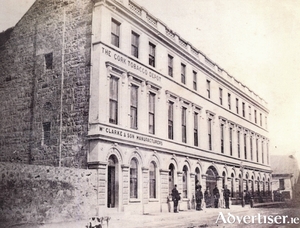
“An important structure is now in the course of completion in ‘the citie of the tribes,’ which will supply a decided want in that hitherto neglected town, but destined – we trust at no distant period – to be a great highway from the Old to the New World. Very little indeed has been done in Galway in the way of building improvements, but a wide field is now being opened; and as transatlantic commercial intercourse increases, so must her prosperity and architectural requirements,” so began an exciting article in the Dublin Builder of January 1, 1860.
The Colonial Buildings

“An important structure is now in the course of completion in ‘the citie of the tribes,’ which will supply a decided want in that hitherto neglected town, but destined – we trust at no distant period – to be a great highway from the Old to the New World. Very little indeed has been done in Galway in the way of building improvements, but a wide field is now being opened; and as transatlantic commercial intercourse increases, so must her prosperity and architectural requirements,” so began an exciting article in the Dublin Builder of January 1, 1860.
Galway Dominicans, a brief history

The Dominican Order was formally approved by Pope Honorius III in 1216, “to witness to the truth of the Christian Faith and to proclaim it at home and abroad”. St Dominic died in 1216, and in 1224 the Dominicans first came to Ireland. They came to Connacht, to Athenry, in 1241, and they finally arrived in Galway in 1488.
St Augustine’s Fort/Forthill
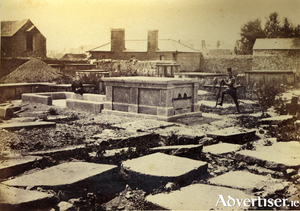
The site of the Augustinian House when the order first came to Galway in 1508 was on the hill we know as Forthill today. Margaret Athy, the wife of the Mayor Stephen Lynch, invited them and she built a church and steeple there too. Her husband was away in Spain and got a shock when he returned to see the finished new building on the hill. The friars moved into a house within the walled city but their church was still between the city and the bay.
The Salmon Weir Bridge
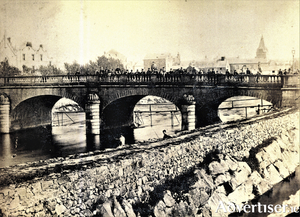
The foundation stone for this bridge was laid on June 29, 1818, by William Le Poer Trench and the structure was completed the following year. The original purpose was to connect the new County Courthouse with the County Gaol on Nuns' Island. It is a fine gently humped five-span bridge which was originally known as ‘The New Bridge’ or ‘Gaol Bridge’.
The Model School

The Model School on Newcastle Road was built in 1849/50 for a cost of £2,533 plus £800 for the furniture. It was one of a series of Model Schools built around that time and was the only one constructed under budget. It opened in July 1852, 170 years ago this month. It catered for Protestant children.
The Browne Doorway
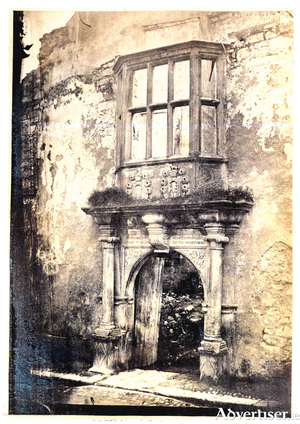
According to a Browne family tradition, the first Browne to settle in Ireland was Phillipus de Browne who in 1172 was appointed Governor of Wexford. He had three sons, one of whom, Walter, settled in County Galway, where his posterity still remains. By around the year 1300, the Brownes seemed to have settled in the Athenry area. They were one of the 14 families from the Irish lower classes who rose to become Galway’s prime merchant families, and who famously were known as The Tribes of Galway.
Queen’s College, Galway/UCG/NUIG, one hundred and seventy years
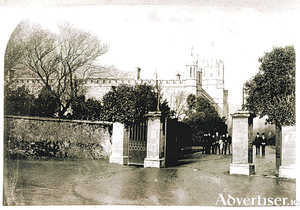
The history of Galway as an educational centre dates from the close of the Middle Ages. The Free School of Galway became so celebrated for its classical learning that it had more than 1,200 students from all over the country attending its courses under Alexander Lynch in 1615, when it was suppressed by King James I.
Banks Castle
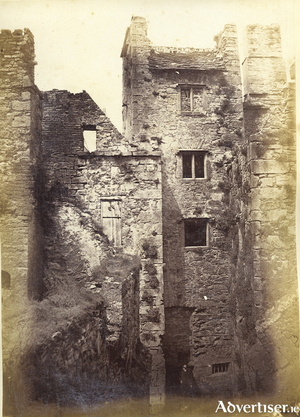
We came across this drawing in the National Library titled “A narrow street in Galway, c.1840-1850”. The clue is in the handwriting at the top of the image, ‘Castle Bank’. In fact, it was a courtyard, not a street, looking at the back of Banks Castle off High Street. Our photograph (courtesy of the Chetham Library in Manchester), shows us much the same view about 25 years later. The property is now part of the King’s Head.
The first steamboat on Galway Bay
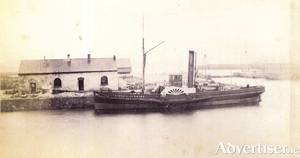
The Citie of the Tribes was the name given to the first steamboat to sail on the bay. She was built in South Shields and registered on December 24, 1872, for the pioneering Galway Steamboat Company and her arrival here was hailed as the precursor of the new shipping millennium, the era of steam.

